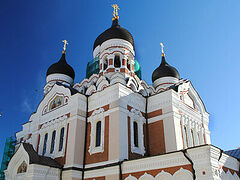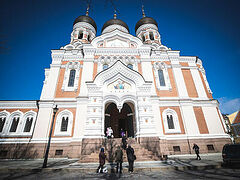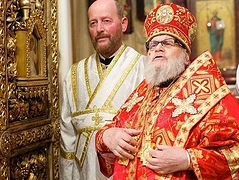 Bishop Daniil of Tartu. Photo: err.ee
Bishop Daniil of Tartu. Photo: err.ee
In Estonia, the authorities demand that the Estonian Orthodox Church of the Moscow Patriarchate (EOC MP) clearly state its position on leaving the subordination of the Russian Orthodox Church (ROC) by the end of July. However, the EOC MP wishes to approach this issue calmly and judiciously, as well as in accordance with legal norms, reports Estonian news agency ERR.
“Today we say that a person in charge was wrong. So I transfer to the canonical leadership of another. Tomorrow, that person makes a mistake. So I should seek a third one? This has never happened in the Church, and I would very much like it to remain so now, after state intervention. In politics, we see people changing, governments changing, parties changing—all this happens very quickly. In the church, we expect a somewhat different approach,” said Bishop Daniil of Tartu, vicar of the Tallinn diocese.
When asked if the state could enforce a forced break in subordination, Bishop Daniil replied that on Monday, EOC MP lawyers had communicated with the head of the Religious Affairs Department of the Ministry of Internal Affairs, noting that the ministry seems in no hurry.
When Russia began its special military operation in Ukraine, heads of the Estonian state followed the lead of the Ukrainian government in placing strictures on the autonomous church under the Moscow Patriarchate. In Ukraine, this has led to legislative proposals to change the name of the UOC or ban it outright, thus legalizing the confiscation of its property or revoking its use by the Church. In Estonia, the state has gradually increased its pressure EOC to break completely from the MP, and declare itself completely independent. Steps have been taken to signal this, such as revoking the EOC’s lease on its office space in Tallin, and forcing Metropolitan Evgeniy of Tallin and All Estonia to leave Estonia.
At the beginning of June, ERR reported that Estonian authorities were demanding that the EOC completely break with Moscow. The ostensible bone of contention is their perception of His Holiness Patriarch Kirill’s support of the Special Military Operation, based on his statements to the effect that this is a war against satan, and that soldiers who defend their fatherland are fulfilling a sacred duty to God—more precisely, that Greater love hath no man than this, that a man lay down his life for his friends, (John 15:13).
The pressure especially increased after media reports on a meeting of the World Russian People’s Council on March 27–28, 2024. At this council, a document was published which various western media interpreted as stating that the conflict in Ukraine is a “Holy War,” aiming to extinguish Ukrainian independence and impose Russian rule.
OrthoChristian asked a hieromonk who was present at the meeting about this, and his reply was that such a statement was not made by a Church official, in fact it’s not clear that any such statement was made at the meeting—even though a document to that effect appeared on the Patriarchal website.
In any case, Bishop Daniil of Tartu responded to this scandal in a meeting at a press conference on April 9:
“The Estonian Orthodox Church of the Moscow Patriarchate (EOC MP) has no grounds for breaking ties with the Russian Orthodox Church, as the document adopted at the Russian People’s Council is not a decision of the Church but the position of a public organization, which even contradicts the official documents of the church…”
“If we touch on topics related to the war, we emphasize that the Church’s preaching should be above any so-called political struggle. We in the Church should not engage in politics. Not from any side—whoever’s politics it may be. There are many refugees from Ukraine in our churches, people who have found themselves here, fleeing from the war. In a way, you could say they are a litmus test. If we were to start endorsing, so to speak, the narrative currently presented by the Russian authorities, it would be completely impossible for them to hear it.
“We are not going to seek another level in our preaching. Just as it was 2000 years ago, the Church is still called to preach that we are all seeking salvation. I once gave the example that even in times of a bad war, an individual can behave well; or, so to speak, in times of a good war, an individual can behave badly. It is always very important to remember this. And our words should be above political topics. This is the word of Christ. It should be what unites us. But if we descend to the political level, we will find much that will divide and separate us.”
Furthermore, Bishop Daniil pointed out that no individual bishop answers for the statements of his Church primate:
“Since our name mentions the Moscow Patriarchate, this causes misunderstanding. It is said that we are under the direct leadership of the Moscow Patriarchate and the Russian Orthodox Church. An attempt has been made to place direct responsibility on us for the words of Patriarch Kirill. This is not the case. I would say even more: The bishops in Russia are also not directly subordinate to the Moscow Patriarch. Only the churches in the Moscow diocese are under his direct authority.”
***
Christianity came to Estonia in the 11th–12th centuries. By the 13th century, the influence of the Novgorod Republic brought Eastern Orthodox Christianity to eastern Estonia, particularly in the area around the town of Narva.
In the early 18th century, Estonia came under Russian rule following the Great Northern War. During this period, Orthodox Christianity began to spread more widely, particularly among the Estonian peasantry.
The Russian Empire supported the establishment of Orthodox churches, and many Estonian peasants converted. This period saw the construction of many Orthodox churches and the establishment of the Orthodox Diocese of Riga, which included Estonia.
It can be argued that official Estonia’s view of Church matters reflects its desire for independence. After the fall of the Russian Empire and the Bolshevik revolution, in 1918 Estonia declared its independence. With fierce religious persecutions in the Soviet Union, direct communication with the Moscow Patriarch was disrupted, and the Constantinople Patriarch offered the Estonian Church a tomos of autonomy in 1923.
In 1940, the Soviet Union annexed Estonia, and the Estonian Church returned to the Moscow Patriarchate. After the breakup of the USSR and Estonian independence, part of the Estonian Church returned to Constantinople (now the EAOC) in order to underscore Estonian nationality, while a large part remained with the Moscow Patriarchate (EOC) by choice. The EAOC is mainly comprised of ethnic Estonians, while the EOC MP predominantly serves the Russian speaking population—although there are entire Estonian nationalities that confess Orthodoxy in the EOC, such as the Setu. The strictly Russian speaking population, made up of Russians, Ukrainians, and Belorussians now living in Estonia, totals about 27 percent of the entire Estonian population. Most ethnic Estonians are Lutherans, or do not confess Christianity at all.
The two Church structures have generally maintained mutual peace. Estonia is also home to the famous Russian Orthodox Pukhtitsa Convent, founded by St. John of Kronstadt, which was never closed under the soviets.



